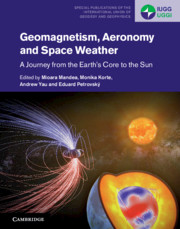Book contents
- Geomagnetism, Aeronomy and Space Weather
- Special Publications of the International Union of Geodesy and Geophysics Series
- Geomagnetism, Aeronomy and Space Weather
- Copyright page
- Contents
- Contributors
- Preface
- Part I Introduction
- Part II Geomagnetic Field
- 4 Geomagnetic Field Sources
- 5 Can Paleomagnetism Distinguish Dynamo Regimes?
- 6 Geomagnetic and Electromagnetic Observations at Ground Level
- 7 Modelling Internal and External Geomagnetic Fields Using Satellite Data
- 8 New Insights in Far-Space Measurements
- Part III Spatial and Temporal Variations of the Geomagnetic Field
- Part IV Space Weather
- Part V Magnetic Fields beyond the Earth and beyond Today
- Index
- References
8 - New Insights in Far-Space Measurements
Large-Scale Structures and Processes in the Solar Wind and Terrestrial Magnetosphere
from Part II - Geomagnetic Field
Published online by Cambridge University Press: 25 October 2019
- Geomagnetism, Aeronomy and Space Weather
- Special Publications of the International Union of Geodesy and Geophysics Series
- Geomagnetism, Aeronomy and Space Weather
- Copyright page
- Contents
- Contributors
- Preface
- Part I Introduction
- Part II Geomagnetic Field
- 4 Geomagnetic Field Sources
- 5 Can Paleomagnetism Distinguish Dynamo Regimes?
- 6 Geomagnetic and Electromagnetic Observations at Ground Level
- 7 Modelling Internal and External Geomagnetic Fields Using Satellite Data
- 8 New Insights in Far-Space Measurements
- Part III Spatial and Temporal Variations of the Geomagnetic Field
- Part IV Space Weather
- Part V Magnetic Fields beyond the Earth and beyond Today
- Index
- References
Summary
Scientific results about space physics in the solar system and obtained from space missions are presented, concentrating on observations from the past decade. After giving the most exhaustive possible list of missions having journeyed in the solar system these past twenty years, the paper presents new insights gathered on the solar wind focusing in particular on results obtained with SOHO, STEREO, ACE and Wind. Then, new results are also presented regarding the terrestrial space environment focusing specifically on data gathered by Cluster, Polar, THEMIS, GEOTAIL and Double Star.
Keywords
Information
- Type
- Chapter
- Information
- Geomagnetism, Aeronomy and Space WeatherA Journey from the Earth's Core to the Sun, pp. 98 - 112Publisher: Cambridge University PressPrint publication year: 2019
